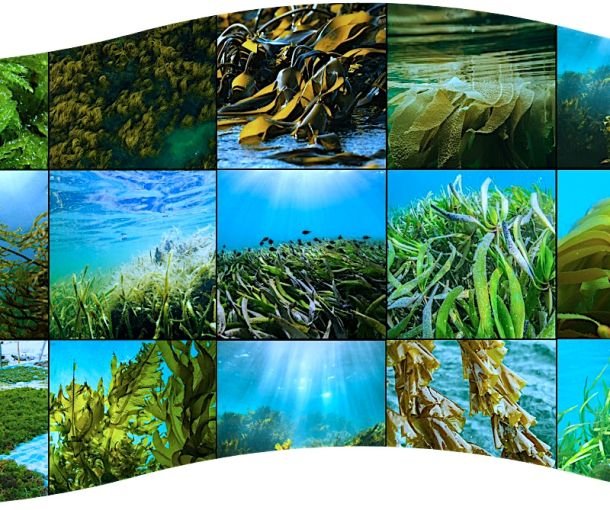The Science of Seaweed Macroalgae Biomaterials: Pioneering a Regenerative Future

Introduction
The science of biomaterials is an interdisciplinary field that involves the study of materials that can be used in living systems or that interact with living tissues. Biomaterials can be synthetic or natural in origin, and they are designed to mimic or interact with biological systems in order to perform specific functions. The development of biomaterials requires an understanding of the properties and behaviors of materials at the molecular, cellular, and tissue levels.
In the ever-evolving tapestry of scientific discovery, the realm of biomaterials science holds a unique and awe-inspiring place. It is a multidisciplinary playground where scientific innovation, engineering ingenuity, and the marvels of nature converge. At its heart, biomaterials science seeks to understand, harness, and manipulate materials that interact seamlessly with living systems or mimic biological processes. These materials, whether born in the laboratory or found abundantly in the natural world, are poised to redefine industries, medical treatments, and environmental sustainability. Understanding the science of biomaterials demands a profound exploration of materials’ properties and behaviors at the molecular, cellular, and tissue levels within the intricate context of living organisms.
Amidst this captivating journey through the science of biomaterials, there emerges an unlikely hero: seaweed macroalgae. These unassuming marine organisms, often swaying gently in the currents of our planet’s oceans, possess an extraordinary potential to transform the landscape of biomaterials. Seaweed, with its inherent abundance, renewability, and a treasure trove of diverse chemical and physical properties, emerges as a beacon of hope and innovation in the quest for sustainable biomaterials. Yet, to unlock the full potential of seaweed as a regenerative resource for non-food industries, one must navigate the intricate landscape of biomaterials engineering, where a constellation of factors comes into play.
Extraction and Processing Methods: Pioneering the Journey
The expedition into seaweed macroalgae biomaterials commences with the vital steps of extraction and processing. These early stages wield immense influence over the properties and quality of the resultant biomaterials. Variables such as temperature, pH, and processing duration hold the power to sculpt the chemical composition and physical characteristics of these materials. The choice of method, whether it entails enzymatic processes, mechanical extraction, or solvent-based techniques, becomes the key that unlocks the vast potential of seaweed as a biomaterial resource.
Chemical and Physical Properties: The Poetry of Nature’s Toolbox
Seaweed macroalgae, the versatile denizen of the seas, houses an array of chemical compounds, each with the potential to give life to a diverse range of biomaterials. Polysaccharides, proteins, minerals – these are the words written in nature’s script that can craft materials of remarkable utility. But it’s not just the chemical constituents that matter; the physical properties of seaweed play an equally pivotal role. Texture, water content, and structural integrity are the elements of this symphony that influence the final biomaterial product’s composition and performance.
Biocompatibility: The Dance of Materials and Life
In the world of biomaterials, biocompatibility is the sacred covenant. Materials derived from seaweed must perform a delicate ballet with biological systems, avoiding any discordant notes of immune responses or toxic reactions when in contact with living tissues. Achieving biocompatibility is a complex endeavor, where factors like the chemical composition, surface properties, and degradation rates of the biomaterials must harmonize with the rhythms of life. It is a relentless pursuit of functionality entwined with safety.
Mechanical Properties: The Unseen Strength
Mechanical Properties: The Unseen Strength
Within the intricate realm of biomaterials, mechanical properties stand as the uncelebrated heroes, quietly shaping the suitability of materials for their intended tasks. The mechanical properties of biomaterials derived from seaweed macroalgae emerge as a crucial facet, particularly when meticulously engineered to meet the precise demands of specific applications.
Tensile Strength: The Backbone of Structural Integrity
Tensile strength, often considered the backbone of structural integrity, defines a biomaterial’s ability to withstand stretching forces without succumbing to deformation or failure. In the context of seaweed-derived biomaterials, tensile strength plays a pivotal role in applications where materials must endure tension and stretching. This property is vital for creating durable and resilient biomaterials, whether they serve as scaffolds for tissue engineering or components in load-bearing structures.
Elasticity: The Art of Resilience
Elasticity is the art of resilience that allows biomaterials to return to their original shape after experiencing deformation. This property is essential in scenarios where biomaterials need to withstand repeated stresses or deformations. For seaweed-derived biomaterials, elasticity ensures that they can maintain their structural integrity and performance even under dynamic conditions. It’s a characteristic that makes these biomaterials adaptable and suitable for applications ranging from wearable medical devices to flexible packaging.
Toughness: The Measure of Durability
Toughness, often referred to as the measure of durability, encapsulates a biomaterial’s ability to absorb energy without breaking. In practical terms, toughness signifies the capacity of a biomaterial to endure impacts or sudden forces without catastrophic failure. For biomaterials derived from seaweed macroalgae, toughness can be a critical attribute, particularly in applications where they need to withstand harsh environmental conditions or provide impact resistance. This property ensures that seaweed biomaterials maintain their functionality and structural integrity over time, contributing to their longevity.
In the grand tapestry of biomaterials science, these mechanical properties are the hidden champions, dictating the success and reliability of biomaterials in diverse applications. Seaweed-derived biomaterials, meticulously engineered to exhibit the desired tensile strength, elasticity, and toughness, promise to be versatile and resilient solutions that can thrive in the most demanding environments. Whether they’re reinforcing medical implants for longevity, underpinning the construction of eco-friendly buildings, or enhancing the performance of sustainable textiles, the mechanical prowess of seaweed biomaterials is the bedrock on which their multifaceted potential is built.
Environmental Sustainability: A Promise to the Planet
In an era of heightened environmental consciousness, sustainability takes center stage. The journey of seaweed biomaterials must navigate the seas of environmental impact. Sustainability encompasses not only the practices of seaweed harvesting but also their effects on marine ecosystems. It extends to the carbon footprint incurred during processing and manufacturing. True sustainability requires us to be mindful stewards of the environment, ensuring that our biomaterial endeavors are in harmony with the world we seek to preserve.
In this ever-evolving landscape of biomaterials science, seaweed macroalgae emerge as a protagonist with boundless potential. They offer both versatility and sustainability, guiding us toward a regenerative future across non-food industries. The science of biomaterials provides the foundation, and the biomaterials engineering factors serve as the compass, guiding us on this remarkable journey, where nature’s offerings and human ingenuity converge to forge a sustainable, innovative, and effective biomaterial future.
References:
Wang, L., Wang, A., & Wu, H. (2021). Seaweed-based biomaterials: Extraction, characterization, and applications. Comprehensive Reviews in Food Science and Food Safety, 20(6), 3986-4013.
Chan, E. S., & Lee, B. B. (2019). Seaweed-based sustainable packaging materials and their applications. In Green Packaging for Food Packaging (pp. 83-114). Woodhead Publishing.
Zia, K. M., Tabasum, S., & Nasif, M. (2020). Seaweeds: A sustainable feedstock for bioplastics and its environmental sustainability. Environmental Science and Pollution Research, 27(15), 17400-17415.
Silva, T. H., Alves, A., Ferreira, B. M., Oliveira, J. M., & Reys, L. L. (2021). Seaweed polysaccharides and their potential application in drug delivery and tissue engineering. Marine Drugs, 19(5), 270.
BLU3 is developing a variety of new products based on biomaterials derived from macroalgae. Stay tuned for new product announcements for the regenerative future.


